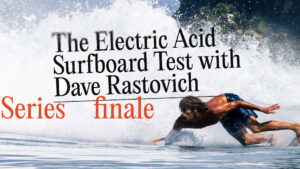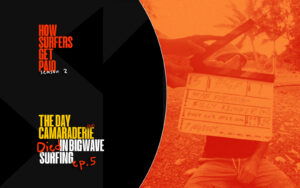Rip Curl’s Mirage shoot in Fiji
Cooking up a new way to promote trunks isn’t easy. In an endeavour to pump up their Mirage Boardshorts, Rip Curl decided to link up with TimeSlice films and employ a technology you may remember from the Matrix trilogy. After an expensive venture to Malaysia three years ago, to shoot their teamers in the Sun Way Lagoon Wavepool, the Curl recently decided to take TimeSlice to Namotu, Fiji. The tech (which, in essence, is a rig of multiple cameras that shoot simultaneously), allows filmers to run motion footage, freeze the frame, change angles, then continue with motion footage from the new angle. In Fiji, GoPros were used instead of the Canon SLRs chosen for the Malaysia effort. It was just before the Billabong Pro, J-Bay back in July that the Rip Curl crew trickled into Namotu and set to work. One of the surfers there was Matty Wilkinson, a goofy-footed Australian who rolls with the punches and never lets the real world thunder by him. When Stab dialled in with Matt, he was sitting down to lunch after winning his first heat at the O’Neill Cold Water Classic in Santa Cruz. Stab: Where’d you personally scoop the best footage? Matty Wilko: All the best footage I got was Cloudbreak, I think. And, maybe a few little clips at Restaurants. But it’s pretty hard to do good shit out there ’cause it’s so shallow, it’s kinda scary. You try and mix it up and you end up doing a little snap and dropping into a little barrel. No matter what line you take, you end up in the same spot. Something you don’t wanna let go off. Photo: Trent Mitchell Is it tough pulling focus when you’ve got a PWC and sizeable camera rig buzzing around? Yeah, for sure. With all the cameras in the water – they’re all swimming around with poles that are 20 cameras-long – it was like having someone holding a mal up in the air and then trying to do an air over it. It was pretty hard to figure out where I needed to be, ’cause with fisheye lenses you need to be so close, but then the thing’s so big that if you do something wrong you’re gonna hit it and ruin the day. Do you feel like there’s more pressure, surfing around that technology, like you’re going to have your surfing really slowed down and dissected? Yeah, kinda. It was more excitement than pressure, ’cause you think, if you do get something right, then it’s gonna look so sick. You get kinda angry with yourself if you fuck up, but if you do something right it’s more rewarding when there’s that kinda technology to capture it. A makeshift workshop and an extravagant camera rig. Photo: Ted Grambeau Who got the best stuff? I don’t actually know. We didn’t get to see any of it ’cause once they shoot it, it all goes to the guys in England that do whatever it is that they have to do to it. We got to see two random little clips, but there’s so much they have to do to it that we never really got to see the finished product. How’d it differ from the Malaysian Wavepool shoot? Well, in Malaysia, it was just one frame, a photo, with 50 cameras. But in Fiji it was video, so instead of doing something and hoping the photographer pressed the button at the right time, you could get the whole turn and then shift angles mid-turn, which was really cool. Distracting? Yes. Worthwhile? Yes. Photo: Ted Grambeau Photo: Stuart Gibson
Cooking up a new way to promote trunks isn’t easy. In an endeavour to pump up their Mirage Boardshorts, Rip Curl decided to link up with TimeSlice films and employ a technology you may remember from the Matrix trilogy. After an expensive venture to Malaysia three years ago, to shoot their teamers in the Sun Way Lagoon Wavepool, the Curl recently decided to take TimeSlice to Namotu, Fiji. The tech (which, in essence, is a rig of multiple cameras that shoot simultaneously), allows filmers to run motion footage, freeze the frame, change angles, then continue with motion footage from the new angle. In Fiji, GoPros were used instead of the Canon SLRs chosen for the Malaysia effort.
It was just before the Billabong Pro, J-Bay back in July that the Rip Curl crew trickled into Namotu and set to work. One of the surfers there was Matty Wilkinson, a goofy-footed Australian who rolls with the punches and never lets the real world thunder by him. When Stab dialled in with Matt, he was sitting down to lunch after winning his first heat at the O’Neill Cold Water Classic in Santa Cruz.
Stab: Where’d you personally scoop the best footage?
Matty Wilko: All the best footage I got was Cloudbreak, I think. And, maybe a few little clips at Restaurants. But it’s pretty hard to do good shit out there ’cause it’s so shallow, it’s kinda scary. You try and mix it up and you end up doing a little snap and dropping into a little barrel. No matter what line you take, you end up in the same spot.

Something you don’t wanna let go off. Photo: Trent Mitchell
Is it tough pulling focus when you’ve got a PWC and sizeable camera rig buzzing around? Yeah, for sure. With all the cameras in the water – they’re all swimming around with poles that are 20 cameras-long – it was like having someone holding a mal up in the air and then trying to do an air over it. It was pretty hard to figure out where I needed to be, ’cause with fisheye lenses you need to be so close, but then the thing’s so big that if you do something wrong you’re gonna hit it and ruin the day.
Do you feel like there’s more pressure, surfing around that technology, like you’re going to have your surfing really slowed down and dissected? Yeah, kinda. It was more excitement than pressure, ’cause you think, if you do get something right, then it’s gonna look so sick. You get kinda angry with yourself if you fuck up, but if you do something right it’s more rewarding when there’s that kinda technology to capture it.

A makeshift workshop and an extravagant camera rig. Photo: Ted Grambeau
Who got the best stuff? I don’t actually know. We didn’t get to see any of it ’cause once they shoot it, it all goes to the guys in England that do whatever it is that they have to do to it. We got to see two random little clips, but there’s so much they have to do to it that we never really got to see the finished product.
How’d it differ from the Malaysian Wavepool shoot? Well, in Malaysia, it was just one frame, a photo, with 50 cameras. But in Fiji it was video, so instead of doing something and hoping the photographer pressed the button at the right time, you could get the whole turn and then shift angles mid-turn, which was really cool.

Distracting? Yes. Worthwhile? Yes. Photo: Ted Grambeau

Photo: Stuart Gibson
















Comments
Comments are a Stab Premium feature. Gotta join to talk shop.
Already a member? Sign In
Want to join? Sign Up